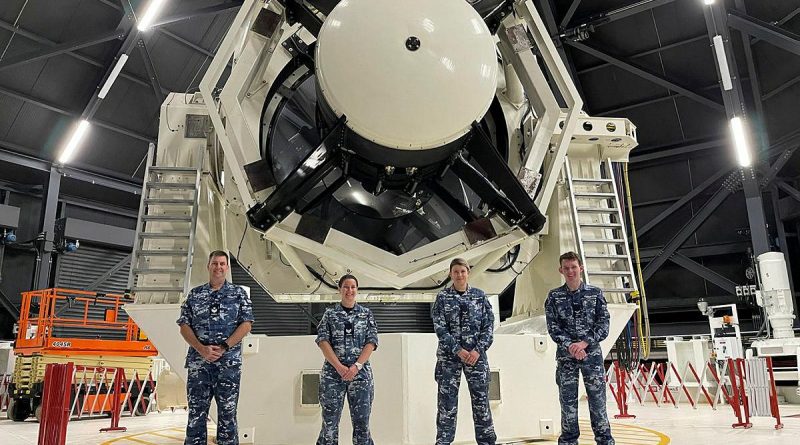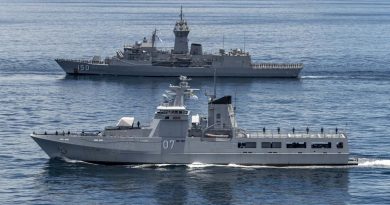Keeping an eye on space traffic

Air surveillance operators at No. 1 Remote Sensor Unit (1RSU) based at RAAF Base Edinburgh have completed training to operate the unit’s newest capability, the Royal Australian Air Force space surveillance telescope (SST).
CAPTION: Air surveillance operators from No. 1 Remote Sensor Unit Flight Sergeant Peter Merritt, left, Sergeant Emma Barker, Leading Aircraftwoman Amy Clements and Leading Aircraftman Corey Tuddenham at the Air Force’s space surveillance telescope in WA. Story by Flight Lieutenant Joseph Noble and Squadron Leader Barrie Bardoe.
The SST will survey the night skies, detecting and cataloguing objects in geosynchronous orbit more than 30,000km above the Earth where many important telecommunications satellites reside.
Inactive satellites and debris litter this orbital plane and pose a collision risk to active spacecraft.
As such, the SST’s detections will help identify such risks and preserve the safe use of space.
Located at the Harold E Holt Communication Station in Exmouth, Western Australia, the SST is positioned close to another 1RSU-operated space domain awareness asset, the C-Band radar.
Both the C-Band and SST are joint initiatives of the United States Space Force (USSF) and Australia.
Both capabilities form part of the space surveillance network, which is a worldwide network of telescopes and radars that detect, track, identify and catalogue man-made objects in space.
Leading Aircraftwoman Amy Clements, an ASOP on the inaugural SST course, said the SST was an electro-optical sensor that would provide coverage of objects within deep space, making an important contribution as part of the space surveillance network.
“Visiting the site of the telescope in May, I had the incredible opportunity to witness first-hand, along with my fellow aviators, what 1RSU and the wider Air Force are looking to achieve within the space domain,” Leading Aircraftwoman Clements said.
“As an operator, I am really excited to have the opportunity to work with this incredible technology and support this enhanced space capability for Air Force.”
With an enormous 3.6m aperture, the SST was initially developed by the Massachusetts Institute of Technology Lincoln Laboratory and is the result of years of construction, testing and development.
The SST is a proven and potent technology, with the United States Air Force previously operating the capability at White Sands Missile Range, New Mexico, prior to its relocation to Exmouth.
Leading Aircraftman Graham Turner, an ASOP at 1RSU and also a member of the first SST course, said the things the SST could see were amazing.
“Operating an optical sensor is quite different to using a radar like C-Band, which I’ve operated previously, and has a lot of advantages, especially in geostationary orbit,” Leading Aircraftman Turner said.
“It’s a different job to what 1RSU has done before in space domain awareness and the SST is especially suited to it.”
Modern military operations are reliant on space-based assets for communications, weather, navigation, timing, intelligence and missile-warning.
Detecting potential collision risks to these assets through space domain awareness increases their survivability and ensures the effects they provide the warfighter are not lost.
Commanding Officer 1RSU Wing Commander Richard Harrison said the SST’s observations would contribute to the ADF’s space domain awareness and that of allies.
“The establishment of the SST capability marks an impressive milestone for our unit and more broadly, Air Force’s collaboration with the US and other agencies within the space sector,” Wing Commander Harrison said.
The first RAAF SST operators completed their training on April 23 and are now developing procedures and trialling techniques towards achieving initial operating capability.
.
.

.
.





